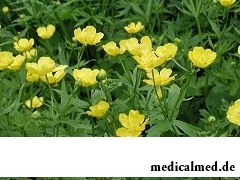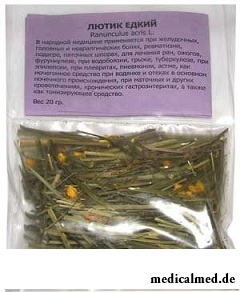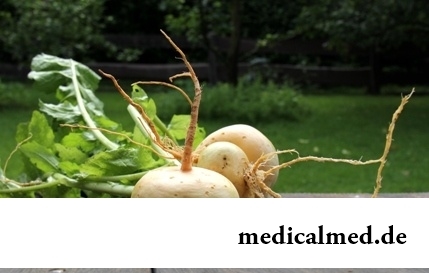





The buttercup is caustic
Application instruction:
 Buttercup caustic – a plant which concerns to family of the Crowfoot family. There is a set of national names of a buttercup caustic among which – an oil flower, a podagrovy grass and a burning grass. In drugstores is on sale under the name "Grass of a Buttercup Caustic".
Buttercup caustic – a plant which concerns to family of the Crowfoot family. There is a set of national names of a buttercup caustic among which – an oil flower, a podagrovy grass and a burning grass. In drugstores is on sale under the name "Grass of a Buttercup Caustic".
Rhizome at a plant – short and reinforced, and from it upright stalks which can reach in height from 30 to 100 cm develop. Such plants are branching, slaboopushchenny and hollow. Bright golden-yellow flowers are located on the ends of branches. Leaves at a buttercup can look differently.
At stem leaves a structure simpler, they are sedentary and have linear shares. A grass blooming period – May-June.
Radical leaves "sit" on long scapes and 5-7-palchatorazdelnymi are. The buttercup on meadows is especially widespread. By the way, its bright flowers do not please peasants at all, the plant is poisonous that is especially bad for the grazed cattle.
Substances lose the caustic force only in the dried-up look for this reason hay with the maintenance of a buttercup caustic for the cattle is safe.
Use
Only elevated part of a plant which is efficient only in a fresh-gathered look is used. It should be noted that in traditional medicine different types of buttercups which have similar outward do not differ.
The major active ingredient which is in a buttercup caustic is protoanemonin which causes irritant action on mucous membranes and on skin. From other useful substances of this plant it is possible to note vitamin C, tannins, asponina, arginine and asparagine. These substances meet not only in a caustic buttercup, but also in all species of this plant.
The buttercup caustic is not used in official medicine!
The buttercup found application in homeopathy. So, for example, bulbous means which is prepared from a buttercup gives good effect at irritation of an oral cavity, nose and an eye, and also at pains in a breast (it can be pains of any sort – from prickings before breath difficulty). The buttercup is used for elimination of pain in muscles. He well copes with skin rashes, even with pustules.
All types of yellow buttercups gained wide recognition in traditional medicine. The most known is burning action of this grass. Even if just to pick a flower, bubbles on hands can act. Unfortunately, the nonconventional medicine nevertheless finds application for fresh leaves of a buttercup caustic, but specialists categorically do not recommend to try at least one way of national treatment.
Traditional medicine applies a buttercup caustic to treatment neuralgic and headaches, wounds, a furunculosis, gout, rheumatism, burns. Though the main substance which contains in a buttercup caustic (protoanemonin) and is toxic, it is capable to stimulate activity of a nervous system in small doses and to increase quantity of erythrocytes.
So, for example, thinly cut buttercups, infused on milk, at strong locks can be good laxative.
Still the French court doctor at Ferdinand І defined external and internal use of flowers at warts.
Harm from use
As it was already told above, the fresh grass of a buttercup caustic is poisonous. Caustic substances which are a part of a plant at external use can irritate mucous membranes and skin. Getting inside, the grass leads intestines and a stomach to irritation, causes gripes and a diarrhea. Somehow to cope with negative effects of poisoning, it is necessary to cause at first vomiting, and then it is obligatory to accept absorbent carbon. All further care of the got poisoned person should be assigned to the doctor. By the way, external skin defeats can take place without traces.
The educated person is less subject to brain diseases. Intellectual activity promotes formation of the additional fabric compensating sick.

Sugar - the digestible refined product which is not of special value for an organism of the modern person. Use...
Section: Articles about health
We present to yours the TOP of the medicamentous means exerting the stimulating impact on a potentiality, i.e. on ability of the man to commission of sexual intercourse. At once it is necessary to tell that not always disturbances of erectile function can be eliminated with reception of t...
Section: Articles about health
(Xerostomia) many people consider feeling of a xerostomia small and easily removable inconvenience. This delusion: the symptom can demonstrate existence of serious diseases. It is worth to remember also that saliva performs important functions in an organism: clears the surface of teeth of a food plaque, growth of pathogenic microorganisms oppresses, normalizes acid-base balance, liquefies food and helps to split the carbohydrates which are contained in it. Chronic deficit слюн...
Section: Articles about health
Neurosis is called pathology of a nervous system at which deviations in functioning of the highest nervous processes are observed. Nye...
Section: Articles about health
Doctors claim that the people not so familiar with a dorsodynia occur among adult Russians very seldom. At the same time the vast majority of the patients who are periodically testing this indisposition do not hurry to ask for medical care at all. With one St...
Section: Articles about health
Statistically, at the address to doctors seven of each ten patients complain of a headache. Actually it is much more people who are periodically feeling unpleasant feelings such. Many people, apart from a headache the reason for serious fears, prefer to muffle independently the next attack medicines. Such behavior is extremely careless, especially if this symptom appears regularly and is followed by other signs of an indisposition. Constants head Bol...
Section: Articles about health
Sooner or later hair turn gray at all. Many people try to hide these changes, returning natural color of the hair with the help about...
Section: Articles about health
Diapers for adults – individual one-time means of hygiene which in some situations is irreplaceable and from such situations any person is not insured. Though nobody perceives need of their use with enthusiasm, however without it to a sra...
Section: Articles about health
People know that thermal sources have salutary force long ago. Treatment by natural waters is one of the most ancient methods of disposal of the most different diseases. Bathtubs, souls, wrappings and inhalations, in combination with water reception inside help to improve a condition of the patients suffering from disturbances of work of a musculoskeletal system, bodies of digestive tract, cardiovascular, nervous, respiratory and secretory system, skin and endocrine п...
Section: Articles about health
Work of a brain is extremely complex and in many respects is not studied yet. It is confirmed also by the features of thought processes which are shown in...
Section: Articles about health
Each person has easy indispositions which he transfers "standing", trying not to ask for medical care. Arguments at the same time are adduced same: "it is a trifle, itself will pass", "I have too many important issues", "there are no wish to spend time on...
Section: Articles about health
Some people consider what for medicine of the 21st century of secrets in the field of health of the person almost does not exist. It absolutely not so. The more answers scientists receive, the more the most difficult questions are raised for them by life. Besides, there are diseases which are not explained with science in any way of which existence people know for 100-150 years. These diseases meet not so often, but from some of them nobody is insured....
Section: Articles about health
Maternal milk is the best food for the newborn. It is the unique natural product containing optimum set...
Section: Articles about health
The healthy nutrition is the invariable principle of health and good health for long years of the woman. Nevertheless, in a diet at each stage of life there are the features allowing to support an organism by those substances which are most necessary...
Section: Articles about health
From the failure of work of immune system which is shown in the form of an allergy, statistically, more than 40% of the population of the globe suffer. In most cases pathological reactions cause the substances which are contained in food stuffs, hair of animals, medicines, goods of household chemicals, cosmetics, pollen of plants, etc. On the one hand, the disease such is capable to spoil quite thoroughly to the person life....
Section: Articles about health
The drugs stopping or oppressing life activity of pathogenic microorganisms are widely applied in clinical practice with 4...
Section: Articles about health
Each failure in work of bodies and systems of a human body is, as a rule, shown by the whole complex of symptoms. In particular, malfunctions with health often cause emergence of cosmetic defects in the form of rashes on a face. Experienced doctors know that локализац...
Section: Articles about health
Zone hypostases under eyes - very widespread problem giving to people is a lot of inconvenience. Hypodermic fabric in these parts has very loose structure and almost does not contain collagenic fibers. Besides, the skin covering подглазья constantly is exposed to compression and stretching when the person blinks, blinks, etc. These features also create premises for emergence of the so-called bags which are giving to the face a tired and sickly look, and also visually adding increased...
Section: Articles about health
Each of us faces from time to time that other people need the immediate help. We react to it on-raznomu:...
Section: Articles about health
The majority of gynecologic diseases prove three main signs, each of which speaks about need of a visit to the gynecologist. Certainly, it is possible to establish the exact diagnosis only after inspection, but on the basis of some signs it is possible пр...
Section: Articles about health
The Genetically Modified Organisms (GMO) are plants or animals (as a rule, agricultural) to whose genotype purposeful changes were made. Opposition of supporters and opponents of inclusion of such organisms in foodstuff always was very acute. Not only scientists and dietitians, but also a large number of the people who are not specialists in this question are involved in active disputes today....
Section: Articles about health
For the time being the perspective of heart diseases seems to most of people remote and foggy. But sooner or later практичес...
Section: Articles about health
Turnip, radish, horse-radish – once these and other products enjoyed wide popularity at our ancestors, being not only the food sating an organism but also the medicines curing of many diseases. Unfortunately, having given the use of some of them...
Section: Articles about health
The phenomenon of the panic attack is known long ago, but the reasons of its emergence still are up to the end not found out. It is established that more than 30% of people at least once in life become the victims of very unpleasant phenomenon: without everyones on that the reasons they have a feeling of horror which is followed by a cardiopalmus, a shiver and the fever or feeling of sudden heat increased by sweating, breath constraint, dizziness, nausea....
Section: Articles about health
Eyes – one of the most vulnerable areas on a face therefore age changes concern them first of all. Whether it is possible to keep a pier...
Section: Articles about health
Life of the modern child is extremely active and difficult. Information strain which is experienced by the school student and did not dream pupils of last times. Careful parents, wishing well to the children, will organize a set of additional classes in circles, sports...
Section: Articles about health
Good appetite was always considered as a sign of good health. The correct operation of the mechanism which is responsible for the need for nutrients and receiving pleasure from process of its satisfaction demonstrates that the organism functions without special deviations. On the other hand, appetite of the person is not a constant. It depends on the culture of food, flavoring addictions imparted since the childhood which can change during life, weather, mood and many д more than once...
Section: Articles about health
